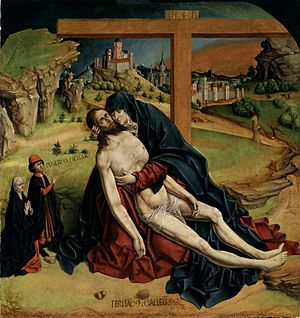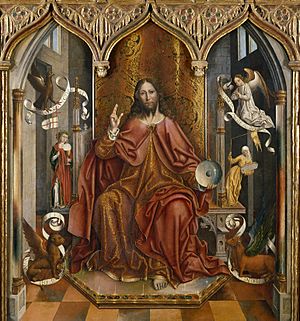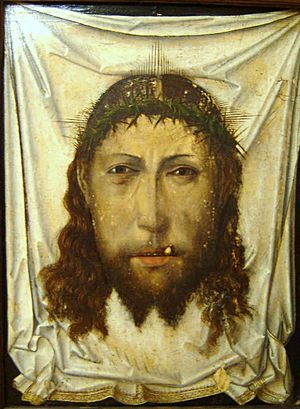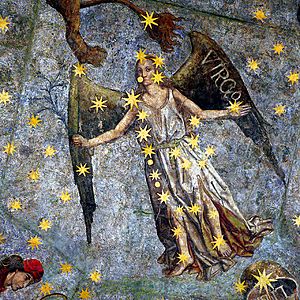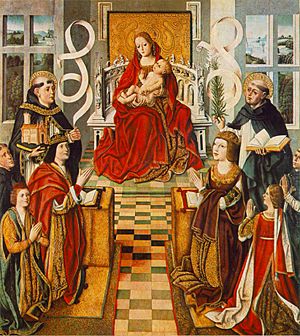Fernando Gallego facts for kids
Fernando Gallego (born around 1440 – died 1507) was a Spanish painter. His art style is often called Hispano-Flemish. This means it mixes Spanish and Flemish (from an area now in Belgium and the Netherlands) painting styles. Gallego was likely born in Salamanca, Spain. He worked in many parts of Spain, especially in cities like Ciudad Rodrigo, Plasencia, and Zamora.
We don't know much about his life. Most of what we know comes from looking at his paintings. The last time he was mentioned in a document was in 1507. This suggests he was still alive then, but we don't know when he died.
Some paintings once thought to be by Fernando Gallego might actually be by Francisco Gallego. Francisco worked in Fernando's art studio. We don't know if they were related.
Fernando Gallego's Art Style
We aren't sure how Fernando Gallego learned to paint. But his art looks a lot like Flemish paintings from the 1400s. He was especially influenced by an artist named Rogier van der Weyden. Flemish painting was very popular at that time. It was known for making things look very real and for using many symbols. Gallego's art shows both of these qualities.
Gallego was very skilled at creating shapes and arranging scenes in his paintings. He was also very creative. This made him one of Spain's best painters during his time. He often added his own artistic touches to his work. He also made each person in his paintings look unique. This made his religious stories more dramatic and showed off his amazing skills.
Most of his paintings were made with oil paint on wooden panels. Early in his career, he also used tempera paint. He worked with another Spanish painter, Master Bartolomé. Together, they created the Retablo of Ciudad Rodrigo. This was a huge religious artwork that showed Christian stories from the Creation to the Last Judgment.
Most of Gallego's art pieces are small religious scenes. These were often put together to form large altarpieces. An altarpiece is a work of art placed behind the altar in a church. One special artwork is the Sky of Salamanca. It is a huge painting on a ceiling at the University of Salamanca. It shows stars and constellations. Only three of Gallego's works have his signature: the Retablo of San Ildefonso, the Pietà at the Prado Museum, and the Virgin of the Rose triptych. Other works are believed to be his because of their style or old documents.
Famous Artworks by Gallego
Retablo of Ciudad Rodrigo (University of Arizona Museum of Art)
This huge altarpiece was painted between 1480 and 1500. It was made by Fernando Gallego's workshop and Master Bartolomé's workshop. We don't know its original size or how it was set up. It was probably added to after it was first put in place. By the early 1800s, it was in bad shape. The panels were taken out of their frames and split up. Twenty-three story panels were sent to London in the 1880s.
Some experts think there might have been more than forty panels in total. But the church where it was located changed in 1502. So, the exact size of the space it filled is still debated. Today, there are twenty-six panels at the University of Arizona Museum of Art. Experts believe Gallego and Bartolomé each painted about half of them.
Here are some of the panels believed to be from Gallego's workshop:
- Predella (the bottom part of the altarpiece): St. Andrew and St. Peter, St. Bartholomew and St. John the Evangelist, St. Mark and St. Thomas.
- Main Altarpiece: The Circumcision, The Charge to Peter, Pilate Washing His Hands, Ecce Homo, Christ and the Samaritan Woman, The Raising of Lazarus, The Agony in the Garden, The Betrayal of Christ, The Healing of the Blind Bartimaeus, Changing the Water into Wine, The Last Judgment.
Even though Gallego didn't sign this work, a document from 1486 lists him as paying taxes in Ciudad Rodrigo. This, along with the painting style, makes experts believe Gallego and his workshop played a big part in creating these panels.
Retablo of San Ildefonso (Cathedral of Zamora)
This artwork does not have a date on it. Experts have suggested different dates for when it was painted. Some think it was made in 1456. Others believe it was as late as 1467. This is thought to be Gallego's oldest altarpiece. It has two main parts, each with three panels. It also has a bottom section (called a banco or predella) with five figures. There are also two side dust covers (called guardapolvo).
The six main panels show different religious scenes:
- Baptism of Jesus
- Christ on the Cross at Calvary
- Martyrdom of John the Baptist
- Apparition of Saint Leocadia
- San Ildefonso Receiving the Chasuble from the Virgin
- Veneration of the Relics of San Ildefonso
The bottom section (predella) shows: Saint John the Evangelist, Saint Nicolas de Bari, Saint Peter, The Holy Face, Saint Jerome, and Saint James. The side dust covers show Eve and Adam at the top. Below them are symbols of the Church and Synagogue. Between the panels, you can see the Cardinal's coat of arms.
This altarpiece was restored between 1966 and 1976. Some paint added later was removed. Most of the panels are in good condition. However, parts of the two middle panels (Christ on the Cross and San Ildefonso Receiving the Chasuble) are damaged.
The Sky of Salamanca (University of Salamanca)
There are no official contracts that prove Fernando Gallego painted The Sky of Salamanca. However, there are documents that mention him. The head of the university, Rodrigo Alvarez, asked for Fernando Gallego to paint the library. This was because Gallego had already worked for the cathedral. Documents also mention his name in connection with painting the library's ceiling. Sky of Salamanca is on the ceiling of the University of Salamanca's library. It shows the latest knowledge about space at that time. It is divided like an astrolabe (an old tool for studying stars). It shows constellations and planets.
Pietà (Prado Museum, Madrid)
Paintings of the pietà became very popular in the late 1400s. A pietà shows Mary holding the body of Jesus after he died. Gallego's version is simple and clear. Mary holding Jesus is placed right in the middle of the painting. The cross is above them. The only other figures are small images of the people who paid for the painting. One of them is praying, "miserere mei due" (have mercy on me, Lord). This prayer is from the Bible and is said on Holy Saturday. In the background, you can see a landscape with a city. This city is probably Jerusalem. This painting, like other pietàs, was meant for religious thought and prayer.
Virgin of the Rose (Cathedral of Salamanca Museum)
Virgin of the Rose is a small altarpiece with three panels. It has been restored and reframed. So, we don't know how the panels were originally arranged. Because it is small, it was probably placed in the cloisters (covered walkways) of the Salamanca Cathedral. It might have been placed over a tomb. The three shields on the altarpiece now have symbols of saints. These include a rose bush for the Virgin Mary, a tree for Saint Andrew, and a laurel branch for Saint Christopher. However, these symbols were painted over the original family coats of arms. Gallego's signature can be clearly seen under the Virgin's robes.
See also
 In Spanish: Fernando Gallego para niños
In Spanish: Fernando Gallego para niños


